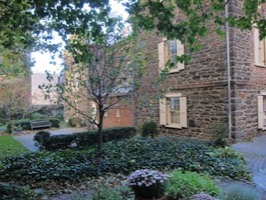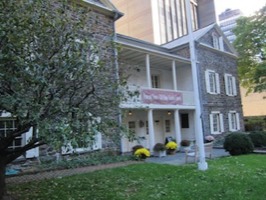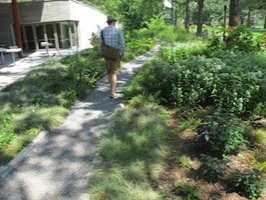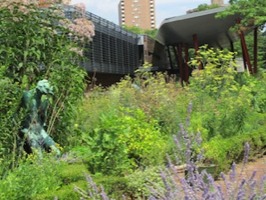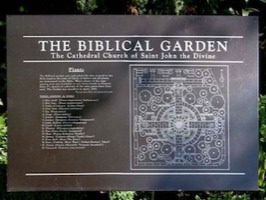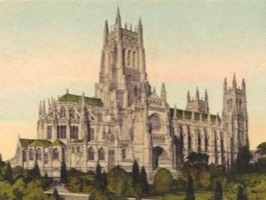
Public gardens of New York City. And a little beyond
Getting off the beaten path. Garden fixes of the usual and the not so usual.
Getting off the beaten path. Garden fixes of the usual and the not so usual.
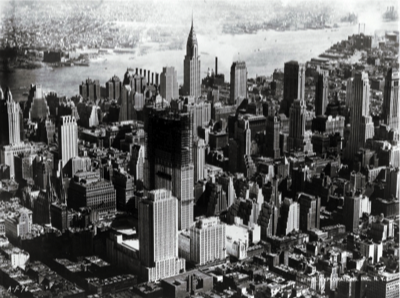
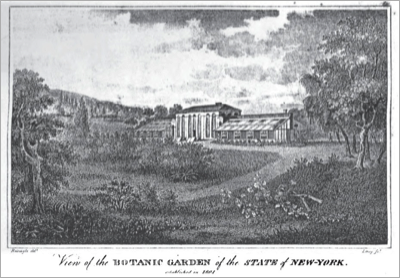
➤ Dr David Hosack (1769-1835) was a leading physician, medical professor, botanist and even a noted mineralogist, who is perhaps best known as the doctor who attended Alexander Hamilton after his infamous duel with Aaron Burr. He started the Elgin Botanic Garden on a grant of fourteen acres from the City of New York for the teaching of his medical students and the benefit of the public. Since plants with medicinal qualities were essential to treating the ailments of patients, establishing such a garden was of great importance to Hosack.
Amazingly, in the 1806 publication of the botanic garden's collection of over 1,500 plants, both the relatively recently described Fuchsia magellanica Lam. (1788) and Fuchsia coccinea Aiton (1789) are already listed. While the former does have some limited medicinal effect as a diuretic, febrifuge and astringent, these mild properties seem not to have been recognized in Hosack's time: The shrubs were more probably grown in his garden for the beauty of their flowers. And the benefit of the public.
In spite of his personal means and considerable connections, Hosack was unable to maintain his private endeavor for long. His attention also went elsewhere as he concentrated on the foundation of Rutger’s Medical College in New Jersey. The garden was purchased by the State of New York in 1810 and placed in the care of the Regents of the University (now SUNY). Abandoned and falling into decay, the land was eventually given by the State for the benefit of Columbia University in lieu of cash in 1814. Today the Elgin Botanic Garden is a long-forgotten memory and Rockefeller Center rises where it once stood. Such is the history of progress in New York City, I suppose.
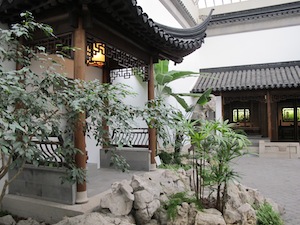
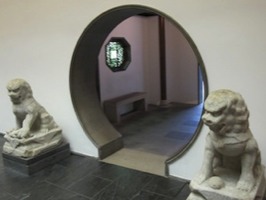
➤ The Astor Court
Metropolitan Museum of Art, 1000 Fifth Avenue, Manhattan
Nestled in the middle of the Metropolitan Museum's Asian Art wing, this serene recreation of a scholar's courtyard garden of the late Ming Dynasty (ca 1630) was modeled after Wang Shi Yuan, the Garden of the Master of the Fishing Nets, in Souzhou.
Metropolitan Museum of Art, 1000 Fifth Avenue, Manhattan
Nestled in the middle of the Metropolitan Museum's Asian Art wing, this serene recreation of a scholar's courtyard garden of the late Ming Dynasty (ca 1630) was modeled after Wang Shi Yuan, the Garden of the Master of the Fishing Nets, in Souzhou.
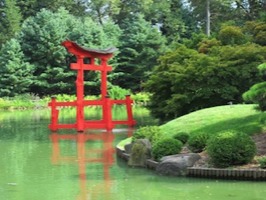
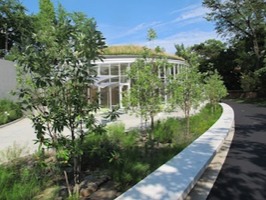
➤ The Brooklyn Botanic Garden
Brooklyn
The Brooklyn Botanic Garden was founded in 1910 on thirty-nine acres and is located in the heart of Brooklyn. It features a stunning cherry blossom display in April, as well as striking Japanese and Rose Gardens. It even has the added bonus of a Fuchsia triphylla in its greenhouse collections. Or had. It unfortunately went missing a couple of years ago.
Brooklyn
The Brooklyn Botanic Garden was founded in 1910 on thirty-nine acres and is located in the heart of Brooklyn. It features a stunning cherry blossom display in April, as well as striking Japanese and Rose Gardens. It even has the added bonus of a Fuchsia triphylla in its greenhouse collections. Or had. It unfortunately went missing a couple of years ago.
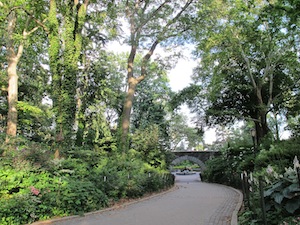
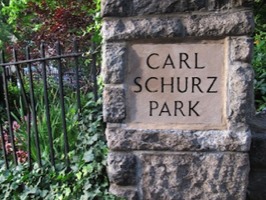
➤ Carl Schurz Park
East End Avenue, Yorkville, Manhattan
This restful park, sitting on a bluff overlooking the swirling waters of Hell Gate, is also home to Gracie Mansion, official residence of New York's mayors, and joins to a popular promenade stretching along the East River.
East End Avenue, Yorkville, Manhattan
This restful park, sitting on a bluff overlooking the swirling waters of Hell Gate, is also home to Gracie Mansion, official residence of New York's mayors, and joins to a popular promenade stretching along the East River.
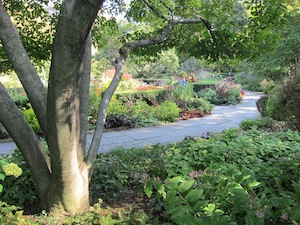
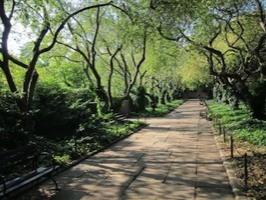
➤ Central Park Conservatory Garden
Fifth Avenue from 104th-106th Streets, Manhattan
A large tropical conservatory was originally built on the site in 1898. The deteriorating complex was demolished in 1937 and replaced with a six-acre formal garden. Don't miss the massive chrysanthemum display put on every fall around the fountain on the northern end.
Fifth Avenue from 104th-106th Streets, Manhattan
A large tropical conservatory was originally built on the site in 1898. The deteriorating complex was demolished in 1937 and replaced with a six-acre formal garden. Don't miss the massive chrysanthemum display put on every fall around the fountain on the northern end.
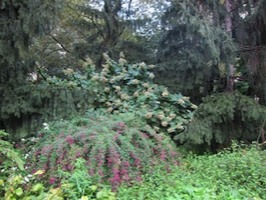
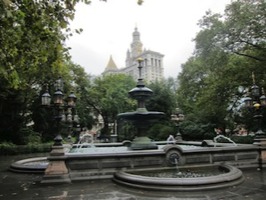
➤ City Hall Park
Broadway at Park Row & Chambers Streets, Manhattan
Located just south of City Hall, this park is a cross section of New Yorkers with lunching government workers, jury members, and newlyweds visiting City Hall for their marriage licenses seen strolling the grounds.
Broadway at Park Row & Chambers Streets, Manhattan
Located just south of City Hall, this park is a cross section of New Yorkers with lunching government workers, jury members, and newlyweds visiting City Hall for their marriage licenses seen strolling the grounds.
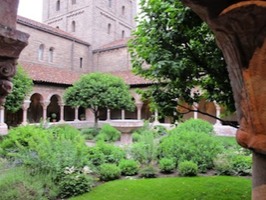
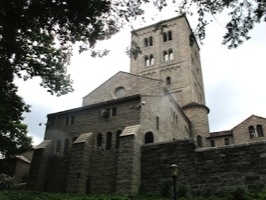
➤ The Cloisters Museum & Gardens
Fort Tryon Park, Manhattan
This branch of the Metropolitan Museum of Art is dramatically perched on a rocky crag in Fort Tryon Park at the upper tip of Manhattan and features medieval art set against a splendid backdrop of medieval-style gardens in its cloistered courtyards.
Fort Tryon Park, Manhattan
This branch of the Metropolitan Museum of Art is dramatically perched on a rocky crag in Fort Tryon Park at the upper tip of Manhattan and features medieval art set against a splendid backdrop of medieval-style gardens in its cloistered courtyards.
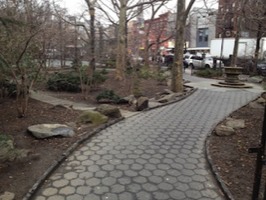
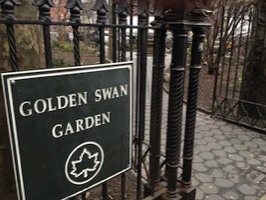
➤ The Golden Swan Garden
6th Avenue & West 4th Street, Manhattan
This charming triangular park is all that remains of a seedy Greenwich Village saloon once frequented by many famous artists and playwrights. The saloon was demolished in 1928 during construction of the Sixth Avenue subway.
6th Avenue & West 4th Street, Manhattan
This charming triangular park is all that remains of a seedy Greenwich Village saloon once frequented by many famous artists and playwrights. The saloon was demolished in 1928 during construction of the Sixth Avenue subway.
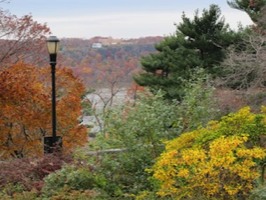
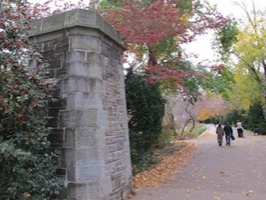
➤ The Heather Garden
Fort Tryon Park, Manhattan
With views that sweep across the Hudson River to the Palisades, the Heather Garden's three acres make it the largest heather and heath garden on the East Coast of the United States. This New York gem is located just inside the main gate to Fort Tryon Park, designed by the Olmstead Brothers in 1935.
Fort Tryon Park, Manhattan
With views that sweep across the Hudson River to the Palisades, the Heather Garden's three acres make it the largest heather and heath garden on the East Coast of the United States. This New York gem is located just inside the main gate to Fort Tryon Park, designed by the Olmstead Brothers in 1935.
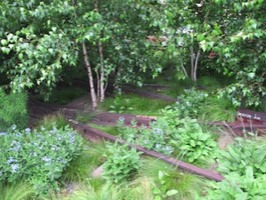
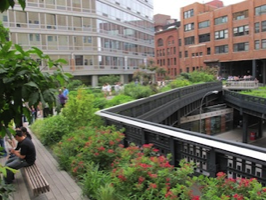
➤ The High Line
Sections 1 & 2 - Gansevoort to West 30th Street, Manhattan
The first part of this remarkable promenade and garden, situated atop an abandoned elevated track once used for freight trains, opened in 2009. Section 2 was added in June, 2011. A third part is under construction and will eventually extend the High Line's length to West 34th Street.
Sections 1 & 2 - Gansevoort to West 30th Street, Manhattan
The first part of this remarkable promenade and garden, situated atop an abandoned elevated track once used for freight trains, opened in 2009. Section 2 was added in June, 2011. A third part is under construction and will eventually extend the High Line's length to West 34th Street.
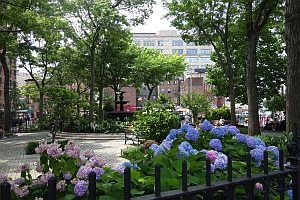
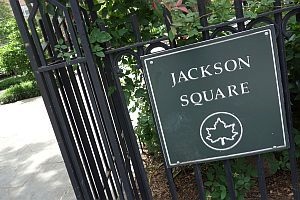
➤ Jackson Square
8th Avenue, Greenwich and Horatio Streets, Greenwich Village, Manhattan
In 1763, an obelisk to Maj. Gen. James Wolfe was erected at the end of Greenwich Avenue, but it mysteriously disappeared from survey maps and historical records in 1773. A triangular park first appears on an 1821 grid map and in 1882 the celebrated architect, Calvert Vaux, was consulted on its redesign. Since then, it Jackson Square had its ups and downs but was restored in 1990, when the splendidly ornate three-tiered fountain was added.
8th Avenue, Greenwich and Horatio Streets, Greenwich Village, Manhattan
In 1763, an obelisk to Maj. Gen. James Wolfe was erected at the end of Greenwich Avenue, but it mysteriously disappeared from survey maps and historical records in 1773. A triangular park first appears on an 1821 grid map and in 1882 the celebrated architect, Calvert Vaux, was consulted on its redesign. Since then, it Jackson Square had its ups and downs but was restored in 1990, when the splendidly ornate three-tiered fountain was added.
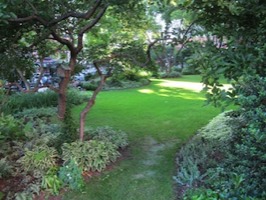
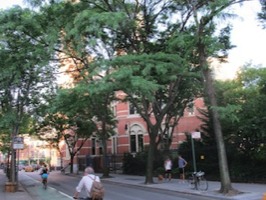
➤ Jefferson Market Garden
Greenwich Avenue, Greenwich Village, Manhattan
This small garden on a third of an acre was named for the food market located here in the early nineteenth century. The ornate Victorian Gothic library building was originally a courthouse and the site of the garden itself once a women's prison.
Greenwich Avenue, Greenwich Village, Manhattan
This small garden on a third of an acre was named for the food market located here in the early nineteenth century. The ornate Victorian Gothic library building was originally a courthouse and the site of the garden itself once a women's prison.
➤ Mt. Vernon Hotel Museum & Garden
421 East 61st Street, Manhattan
Constructed in 1799 as a carriage house to a now-vanished rural estate, the building was converted into a hotel in 1826. It served as a country escape for New Yorkers living in the already crowded city at the southern tip of Manhattan.
421 East 61st Street, Manhattan
Constructed in 1799 as a carriage house to a now-vanished rural estate, the building was converted into a hotel in 1826. It served as a country escape for New Yorkers living in the already crowded city at the southern tip of Manhattan.
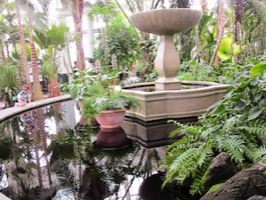
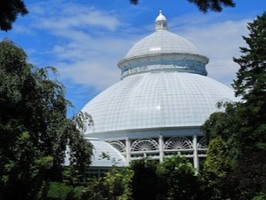
➤ New York Botanical Garden
The Bronx
Founded in 1891 on 250 acres, this is the grande dame of New York area gardens. The NYBG features the splendid Enid A. Haupt Conservatory, as well as a remnant area of native habitat stretching along the Bronx River.
The Bronx
Founded in 1891 on 250 acres, this is the grande dame of New York area gardens. The NYBG features the splendid Enid A. Haupt Conservatory, as well as a remnant area of native habitat stretching along the Bronx River.
➤ Queens Botanical Garden
40-50 Main Street, Flushing, Queens
Originally part of the 1939 New York World's Fair, the garden was afterwards expanded in Flushing Meadows Park. With the1964 World's Fair needing lots of elbow room, though, the QBG was moved across the street and now comprises thirty-nine acres of plantings.
40-50 Main Street, Flushing, Queens
Originally part of the 1939 New York World's Fair, the garden was afterwards expanded in Flushing Meadows Park. With the1964 World's Fair needing lots of elbow room, though, the QBG was moved across the street and now comprises thirty-nine acres of plantings.
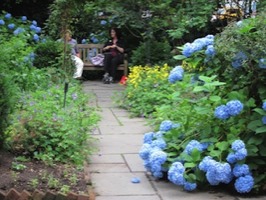
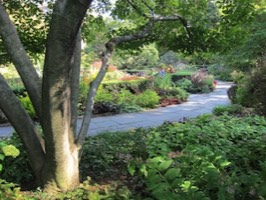
➤ Church of Saint Luke in the Fields
487 Hudson Street, Manhattan
The entrance into this small, peaceful garden on the grounds of an Episcopal church is a bit hard to find, but well worth the effort as the sheltered south-facing grounds contain a number of plants unusual for this far north.
487 Hudson Street, Manhattan
The entrance into this small, peaceful garden on the grounds of an Episcopal church is a bit hard to find, but well worth the effort as the sheltered south-facing grounds contain a number of plants unusual for this far north.
➤ Cathedral of Saint John the Divine
112th Street & Amsterdam Avenue, Manhattan
The grounds of this enormous cathedral of the Episcopal Archdiocese of New York, being constructed in a high Gothic style since 1892, contain a Biblical Garden featuring many of the herbs and flowers mentioned in the Bible.
112th Street & Amsterdam Avenue, Manhattan
The grounds of this enormous cathedral of the Episcopal Archdiocese of New York, being constructed in a high Gothic style since 1892, contain a Biblical Garden featuring many of the herbs and flowers mentioned in the Bible.
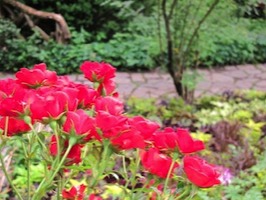
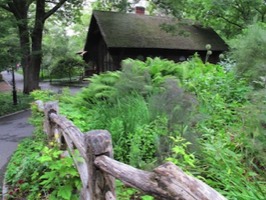
➤ The Shakespeare Garden
Swedish Cottage, Central Park, Manhattan
The garden was first conceived in the 1880s to be adjacent to the nature study center in the Swedish Cottage. In 1913, it was officially dedicated to Shakespeare and is punctuated by several bronze plaques with quotations from his plays.
Swedish Cottage, Central Park, Manhattan
The garden was first conceived in the 1880s to be adjacent to the nature study center in the Swedish Cottage. In 1913, it was officially dedicated to Shakespeare and is punctuated by several bronze plaques with quotations from his plays.
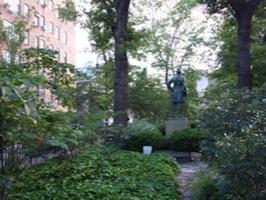
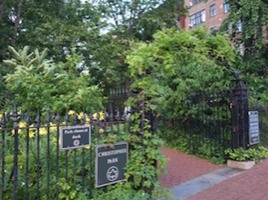
➤ Sheridan Square Viewing Garden
West 4th, Barrow & Washington Place, Manhattan
Located next to the historic Stonewall Inn, the site was a desolate traffic island until 1981, when Greenwich Village residents formed the Sheridan Square Triangle Association. In 1982, they landscaped the plot and planted this charming garden.
West 4th, Barrow & Washington Place, Manhattan
Located next to the historic Stonewall Inn, the site was a desolate traffic island until 1981, when Greenwich Village residents formed the Sheridan Square Triangle Association. In 1982, they landscaped the plot and planted this charming garden.
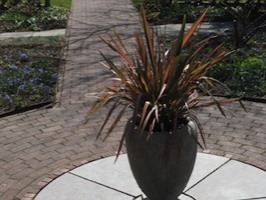
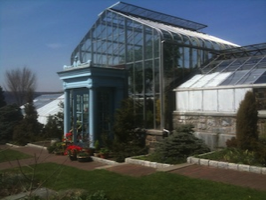
➤ Wave Hill
West 249th Street & Independence Avenue, The Bronx
Wave Hill is a relatively unknown gem of a 28-acre botanical garden in the Bronx especially noted for its dramatic vistas across the Hudson River to the Palisades. Mark Twain once leased the former estate from 1901-1903. A second building housed Bashford Dean’s collection of arms and armor now in the Metropolitan Museum of Art.
West 249th Street & Independence Avenue, The Bronx
Wave Hill is a relatively unknown gem of a 28-acre botanical garden in the Bronx especially noted for its dramatic vistas across the Hudson River to the Palisades. Mark Twain once leased the former estate from 1901-1903. A second building housed Bashford Dean’s collection of arms and armor now in the Metropolitan Museum of Art.
